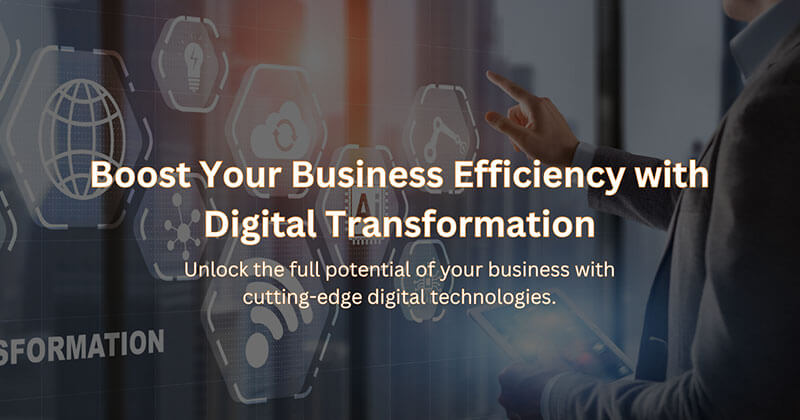How Digital Transformation Can Boost Your Business Efficiency

In today's fast-paced business environment, digital transformation has become a key driver of success. Companies that embrace digital transformation can enhance their operational efficiency, improve customer experiences, and stay ahead of the competition. In this blog, we'll explore how digital transformation can boost your business efficiency and provide actionable insights to help you embark on your transformation journey.
What is Digital Transformation?
Digital transformation involves the integration of digital technologies into all areas of a business, fundamentally changing how you operate and deliver value to customers. It goes beyond simply adopting new technologies; it requires a cultural shift that encourages organizations to continually challenge the status quo and embrace innovation.
Benefits of Digital Transformation
1. Enhanced Operational Efficiency
Digital transformation streamlines processes, automates repetitive tasks, and reduces manual errors. Technologies such as robotic process automation (RPA) and artificial intelligence (AI) can handle mundane tasks, allowing employees to focus on more strategic activities. This not only increases productivity but also reduces operational costs.

2. Improved Customer Experience
By leveraging digital tools, businesses can provide personalized and seamless experiences to their customers. Customer relationship management (CRM) systems, for instance, allow companies to gather and analyze customer data, enabling them to tailor their offerings to meet individual needs. This leads to higher customer satisfaction and loyalty.

3. Data-Driven Decision Making
Digital transformation empowers businesses to make informed decisions based on real-time data. Advanced analytics and big data technologies provide valuable insights into market trends, customer behavior, and operational performance. This data-driven approach helps businesses to identify opportunities, optimize strategies, and mitigate risks.

4. Increased Agility and Innovation
Digital technologies enable businesses to respond quickly to market changes and customer demands. Cloud computing allows companies to scale their operations up or down based on demand. This flexibility fosters a culture of innovation, where businesses can experiment with new ideas and bring them to market faster.

Key Technologies Driving Digital Transformation
1. Cloud Computing
Cloud computing offers scalable and flexible solutions for data storage, processing, and management. It reduces the need for on-premises infrastructure, lowers costs, and provides remote access to resources, facilitating collaboration and productivity. Learn more about cloud computing and its benefits in our detailed blog post on cloud app development.
2. Artificial Intelligence (AI) and Machine Learning (ML)
AI and ML enhance business processes through automation, predictive analytics, and intelligent decision-making. These technologies can optimize supply chains, improve customer service, and enhance product development. Discover how AI and ML can be leveraged in e-commerce in our blog Unlocking AI & ML for Smarter E-commerce.
3. Internet of Things (IoT)
IoT connects physical devices to the internet, enabling real-time data collection and analysis. This connectivity improves operational efficiency, enhances asset management, and supports preventive maintenance. For more insights, check out our blog on IoT's impact on mobile app development.
4. Big Data and Analytics
Big data technologies process vast amounts of structured and unstructured data to generate actionable insights. Analytics tools help businesses understand customer preferences, optimize marketing strategies, and improve operational efficiency.
5. Cybersecurity Measures
As businesses become more digital, protecting sensitive data becomes crucial. Robust cybersecurity measures, such as encryption, firewalls, and multi-factor authentication, safeguard against cyber threats and ensure data integrity.
Steps to Implement Digital Transformation
1. Assess Current Capabilities and Set Clear Goals
Begin by evaluating your current digital capabilities and identifying areas for improvement. Set clear, achievable goals that align with your business objectives.
2. Develop a Digital Transformation Strategy
Create a comprehensive strategy that outlines the technologies, processes, and cultural changes required for digital transformation. This strategy should include a roadmap with specific milestones and timelines.
3. Choose the Right Technology Stack
Select technologies that align with your business needs and goals. Consider factors such as scalability, compatibility, and ease of integration.
4. Train and Engage Employees
Digital transformation requires a skilled and motivated workforce. Invest in training programs to equip your employees with the necessary skills and foster a culture of innovation and continuous improvement.
5. Measure Success and Continuously Improve
Track the progress of your digital transformation initiatives using key performance indicators (KPIs). Continuously evaluate and refine your strategy to ensure it remains aligned with your business goals.
Case Studies and Success Stories
Logoup
https://logoup.com, a retail business, implemented a CRM system to manage customer interactions and personalize marketing efforts. As a result, they saw a 20% increase in customer retention and a 15% boost in sales.
Dintek
https://www.dintek.com.tw/, a manufacturing firm, adopted IoT solutions to monitor equipment performance in real-time. This led to a 30% reduction in maintenance costs and a 25% increase in operational efficiency.
Laenviro
https://laenviro.com, an e-commerce startup, leveraged AI and ML technologies to enhance their product recommendation engine, resulting in a 25% increase in conversion rates and a 20% rise in average order value. Read more about their journey in our blog on AI & ML in e-commerce.
Challenges and How to Overcome Them
1. Resistance to Change
Employees may resist digital transformation due to fear of the unknown. Address this by involving them in the process, providing adequate training, and highlighting the benefits of transformation.
2. High Implementation Costs
Digital transformation can be expensive. Mitigate this by prioritizing initiatives that offer the highest return on investment and exploring cost-effective solutions such as cloud-based services.
3. Data Security Concerns
Protecting sensitive data is crucial. Implement robust cybersecurity measures and ensure compliance with relevant regulations to safeguard your data.

Conclusion
Digital transformation is no longer optional; it's a necessity for businesses aiming to stay competitive and efficient. By embracing digital technologies, you can enhance operational efficiency, improve customer experiences, and drive innovation. Start your digital transformation journey today and unlock the full potential of your business.
Ready to transform your business? Contact us today to learn how our digital transformation services can help you achieve your goals.
Further Reading
For further reading on digital transformation and its benefits, check out these resources:

Shivam Sharma
About the Author
With over 13 years of experience in software development, I am the Founder, Director, and CTO of Zestminds, an IT agency specializing in custom software solutions, AI innovation, and digital transformation. I lead a team of skilled engineers, helping businesses streamline processes, optimize performance, and achieve growth through scalable web and mobile applications, AI integration, and automation.
Stay Ahead with Expert Insights & Trends
Explore industry trends, expert analysis, and actionable strategies to drive success in AI, software development, and digital transformation.

